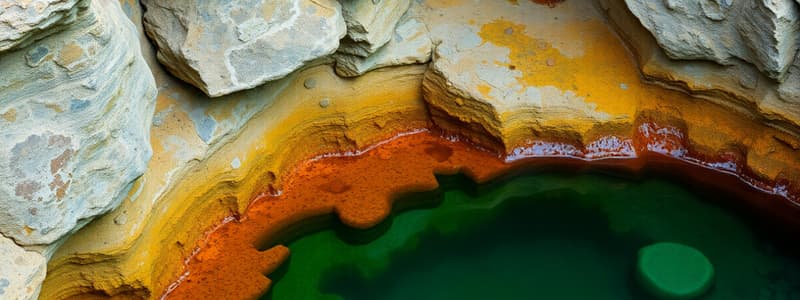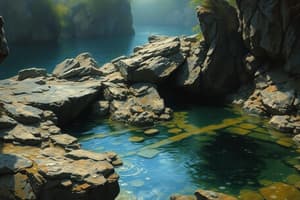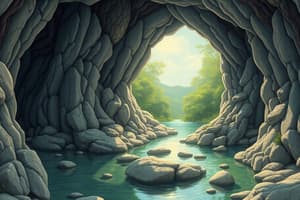Podcast
Questions and Answers
Water from rainwater tanks is safe for consumption without prior purification, regardless of the condition of the roof and gutters.
Water from rainwater tanks is safe for consumption without prior purification, regardless of the condition of the roof and gutters.
False (B)
Spring water's flow rate is solely determined by the water pressure within the aquifer, remaining constant regardless of external factors.
Spring water's flow rate is solely determined by the water pressure within the aquifer, remaining constant regardless of external factors.
False (B)
Rivers play a negligible role in shaping landscapes, primarily serving only as a source of freshwater for various ecosystems.
Rivers play a negligible role in shaping landscapes, primarily serving only as a source of freshwater for various ecosystems.
False (B)
The point where two rivers merge is known as a delta, typically found in the lower course of a river.
The point where two rivers merge is known as a delta, typically found in the lower course of a river.
Surface water is generally safe to drink as it has been naturally filtered, removing all harmful contaminants.
Surface water is generally safe to drink as it has been naturally filtered, removing all harmful contaminants.
Flashcards
Surface Water
Surface Water
Water found on the Earth's surface, like in lakes and rivers. Not safe to drink without treatment.
Rainwater Tank
Rainwater Tank
A storage container that collects rainwater. Water may not be safe to drink without filtration.
Spring
Spring
A natural source of water where underground water comes to the surface.
River
River
Signup and view all the flashcards
Confluence
Confluence
Signup and view all the flashcards
Study Notes
- Surface water is not safe to drink and may contain contaminants like bugs, dirt, rocks, minerals, chemicals, and animal droppings.
- Rainwater tanks collect surface water which may not be safe to drink due to potential contamination from bugs, dirt, minerals, roof debris, and gutter contents.
- Water from rainwater tanks can be used for watering gardens and washing cars or clothes.
- It's important to ensure gutters are clean and free of leaves and animal droppings before using rainwater for drinking
Other Water Sources
- Waterholes, rock holes, and springs provide water from a combination of groundwater and surface water.
Rock Holes
- Rock holes are surface water features holding water in rocky areas.
- They are valuable to Aboriginal people in arid Australia, providing a crucial water supply in dry landscapes, aiding travel and providing access to resources.
Springs
- Springs naturally occur where water emerges from an underground aquifer.
- The amount of water flowing from a spring depends on aquifer pressure, rainfall, and human usage of the aquifer.
- Spring water is usually clear but can be discolored by naturally occurring minerals in the ground.
Rivers
- Rivers are large natural streams of water flowing over land.
- They are essential for human civilization, providing freshwater to people, plants, and animals.
- Rivers are used for transport, water power, and shape the land by carving out valleys and canyons.
River Stages
- Rivers are divided into three stages: the upper course, the middle course, and the lower course.
The Upper Course
- Rain flows downwards in highland areas and collects in channels, forming a stream.
- Streams join together, increasing in size and speed forming a river.
- A confluence is the point where two streams join.
The Creek
- The creek will eventually grow to a river.
- The river flows rapidly in its upper course, cutting through land and picking up soil and gravel.
- Over time, the moving water erodes rock and soil, creating canyons and deep valleys.
The Middle Course
- Fast-flowing water causes erosion making the river deeper and wider.
- The river erodes left and right, forming horseshoe-like loops called meanders.
- Rivers flow down gentler slopes and become larger and slower.
- Soil, gravel, and sand sink to the bottom, forming sandbars and islands.
The Lower Course
- Rivers flow through flatland and flows slowly.
- Because of the slow speed, the water deposits eroded land it has been carrying.
- Rivers drop off more solid material and some is carried to the river mouth, forming a delta.
Erosion and Deposition
- Rivers do not travel in straight lines to avoid obstacles as they flow downhill.
- People have altered river courses over time.
- Erosion and deposition can change the shape of a river.
- Erosion is when materials like soil or rocks are moved by wind or water.
- Sediments are all the materials that undergo erosion.
- Deposition is when sediments are dropped off in a different location.
River Characteristics
- Rivers often turn brown or murky because of the materials they carry.
- As the river reaches its end, it deposits sediments into lakes or oceans.
Meanders
- Meanders can grow, sometimes eroding so much of the river's banks that two meanders merge.
- When meanders merge, the water takes a newer, shorter route.
- Over time, deposition will block off the old part of the river, creating an oxbow lake.
Studying That Suits You
Use AI to generate personalized quizzes and flashcards to suit your learning preferences.




